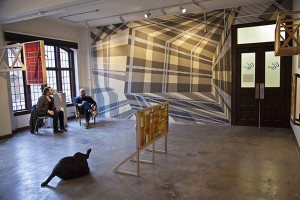The Print Media department is characterized by an expanded concept of printmaking through interdisciplinary practice. This expansive approach to print as process allows for innovation with traditional and new print media. A print can exist as a drawing, graphic, photograph, sculpture, video, sound file, digital file or performance. The department supports a broad investigation of print media. It builds a framework for critique beginning with the historic role of print as a Democratic Voice and continues with media ecology and the circulation of images in the 21st Century.
Challenge begins in the studio. Each student that enters the department should have a high level of self-motivation to create work, a restless curiosity about self and world, the maturity to handle the interface of life and creative practice and be willing to work with others for mutual artistic growth within a constructive but demanding learning environment.
Program
The Print Media Department is a community of individuals from diverse backgrounds that enthusiastically consent to work together and contribute their efforts toward a shared purpose, which is to research, discuss and produce work that will define a leading position within the vanguard of contemporary art practice. Ongoing critical dialogue is fostered through peer review during weekly critiques, one-on-one meetings with the artist-in-residence, weekly reading group, meetings with visiting artists and critics and through the campus wide critical studies program.
The Department’s operation schedule reflects our program’s dedication to the development of each member’s individual studio practice, as well as the growth of a shared set of critical thinking, writing, and social practice skills that will contribute to and advance the discipline of Print Media.
In addition to visits by notable artists, critics, and curators from around the world the department schedules numerous field trips in the City of Detroit. Students have the opportunity to engage with artists, collectives, museums, and galleries in the city. There are also yearly field trips to other cities in the states and abroad.
Facilities
The Print Media Department is located within two adjacent buildings. The department occupies two floors in the Academy Administration building. A cluster of semi-private studios for students, a small computer lab, a critique room, and a kitchen occupy the first floor. The lower level houses recently renovated print shop facilities for water-based screenprinting, intaglio, lithography, and letterpress processes. Additional studios and a large, communal workspace are located across the street in the Lone Pine building. The Academy’s professionally staffed and well-equipped Central Media Lab, Wood Shop and Library further enhance the department’s resources. The metro Detroit business and manufacturing community offers many possibilities for outsourcing of work if required.
This article comes from cranbrookart edit released



